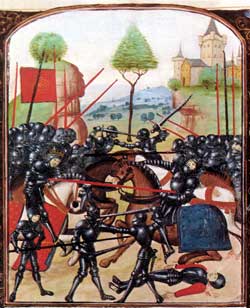Play (1591)
by William Shakespeare
Directed by Tina Packer
Actors’ Shakespeare Project
The Modern Theatre at Suffolk University
Boston
May 13 – June 7, 2015
With Peter G. Andersen (Jourdain, etc.), Steven Barkhimer (Cardinal Beaufort, etc.), Allyn Burrows (Duke of Gloucester, Cade,etc), Nigel Gore (Duke of York, etc.), Jesse Hinson (Henry VI, etc.), Jennie Israel (Margaret, etc.), Marya Lowry (Duchess Eleanor of Gloucester, Richard, etc.), Ross MacDonald (Duke of Somerset, etc.), Craig Mathers (Duke of Suffolk, etc.), Johnnie McQuarly (Warwick, etc.)

There are a ton of characters and a lot going on in this second of Shakespeare’s plays – Henry VI, Part 1 was the very first – but the young playwright, though not totally seasoned, is certainly on, or at least onto, his game.
This production, directed by the great Shakespearean interpreter, Tina Packer, founder and long-time artistic director of Shakespeare and Company in the Berkshires, is vivid, clear, dramatic and funny. One of Packer’s great gifts, as evidenced in all sorts of ways over the years, is to make Shakespeare comprehensible. She certainly achieves that here, and enables it with a good deal of drama and stage action. There is also some humor, though, in this play, it is couched in a strange enough way that, as with all gallows humor, it is wryly funny but hard to extract unbridled laughs from it.
The plot centers around the hapless King Henry, his faithless, manipulative and politically astute wife, Margaret (Jennie Israel), and all the various Dukes who surround them and who are jockeying for power. The play depicts the anxiety-ridden and power-driven setup of the Wars of the Roses, the throne-lust faceoff between the houses of Lancaster (the Henry line) and York (Richard III, etc). What goes into this political grapple-fest between sappy King Henry and his luridly pragmatic retinue – the Duke of York, and all the attendant lords of Suffolk, Warwick, Gloucester, etc – provides the substance of the play.
– Dick, Act IV, Scene 2, Henry VI Part 2
With dozens of characters on the roster, this play could, in this day and age, only be produced by a children’s theater, or, as is the case here, with artful doubling and tripling of the roles. With ten major players in the cast and each one taking two or three parts, the responsibilities get nicely sewn up, and the story is told quite effectively. The recostuming and recharacterizations that are done here work particularly well to distinguish all of the actors in their particular guises, a feat not always pulled off as successfully in other productions I’ve seen.
As the clownish trio of Cade, Smith and Dick, artistic director Allyn Burrows, Steve Barkhimer and long-time Tina Packer colleague Nigel Gore form quite a team. Though their paramilitary cadre is not in itself a barrel of laughs, they certainly are, and one wishes their talents could transpose to one of Shakespeare’s truly funny endeavors. Nevertheless, they offer a great break in the rather dour power plays that prevail through most of the drama. Each of them in other roles is also effective – Gore as the Duke of York, Burrows as the Duke of Gloucester and Barkhimer as the manipulative cleric Cardinal Beaufort.

Jennie Israel is an interesting and compelling Margaret, alluring in her own subtle way and tellingly deceitful. But when Henry confronts her as she strokes her lover’s, Suffolk’s, head (this and Richard Strauss’ opera Salome the two big erotic-decapitation dramas of all time) and wonders whether she’d do the same for him, she tells him she would die for him instead. Israel delivers it with passion, and one almost believes it.
Marya Lowry also pulls one off well as Eleanor, Gloucester’s wife, and in a series of other roles, into which she seems to fit seamlessly. Most notable of those supplementary characterizations which she nails effectively is that of young hunchbacked Richard of York, later to become King Richard III, grim subject of another great Shakespearean history drama.
In all, the cast is highly effective, clear evidence of Packer’s deftness in stimulating them to their best.
Stage action is remarkably lively given several well choreographed sword fights and miscellaneous battles. With ten cast members running, screaming, flying offstage them flying back during those battles, the sense of a well-populated melee, an energetically frenzied scene, certainly comes across effectively.
In the end, however, what really sticks is a sense of the deft way Packer draws Shakespearean language out of the players, delivering a comprehensible sense of the action that flows from carefully assimilated speeches. When done so persuasively, it seems like it’s effortless; but, when one has heard so much Shakespeare done otherwise, one realizes exactly how difficult it is to achieve.
– BADMan


Leave a Reply